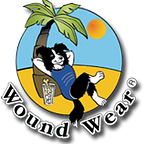A Non-Surgical Approach to My Dog’s ACL Tear: Brace Time
Having a dog with a leg injury is no fun. The limited mobility, wishing they could tell you “where it hurts”, and not allowing them to engage in activities that could worsen their pain (running, jumping, etc), are all factors in any sort of limb or muscle boo boo. My dog partially tore his anterior cruciate ligament (ACL) in his left knee and we are taking the conservative management route. So a non-surgical approach to my dog’s ACL tear is being blogged about for others to learn from our experiences.
In our last blog post about the journey, I shared that Dexter, my then 4-year-old Cocker Spaniel, partially tore his anterior cruciate ligament while playing ball. You can read all about that in our first entry to this ACL injury saga.
Sometimes the ACL is called the CCL, cranial cruciate ligament, and this is the same thing.
UPDATE: Since this post was written, our dog has undergone two ACL complete tears and two successful ACL lateral suture surgeries. We are thrilled to have found a board certified orthopedic surgeon to perform these surgeries locally. However, surgery is not for every dog and not every dog may be a candidate for a variety of reasons.
We opted for cold laser therapy class IV. The cold laser therapy sessions were a shot in the dark, but one I wanted to try in conjunction with the other modalities of treatment we’re doing. After four sessions, I cannot say I honestly see a difference. He isn’t worse but he isn’t “better.” I am keeping in mind that laser therapy is designed to be ongoing and one part of the conservative management approach. I am trying to not go down the surgical route, especially since this is not a full tear. We have 2 sessions left in this course. An ACL tear takes months to heal and many more months before dog parents should engage the dog in their normal activities so as to not have a recurrence or re-injury.
The folks at Dexter’s rehab facility were kind enough to answer my questions about a stifle (knee) brace for Dexter to wear during his recovery process. I learned about My Pet’s Brace, who provide orthotic devices for dogs that require bracing to support hip, stifle, hock and paw injuries in the hind legs and shoulder, elbow and carpal injuries in the front legs. With a prescription in tow and a lot of research under my belt, off we went to the “brace place” for pets. On a side note, the sheer volume of people I have talked to whose dogs have this injury has been overly concerning. We are pet parents with very active dogs, so it’s nice to see veterinary medicine advancing in the direction of care to mirror its human counterparts.
The knee brace that was recommended for Dexter is designed to help him with his damaged ACL. We are told that after an adjustment period of a few weeks, Dexter will be able to resume climbing stairs, playing, and taking longer walks. We love brain games for dogs, but are really ready to put the doggie games under the bed and head back outside to bunnies, squirrels, and squeaky balls.
We met with Jim Alaimo and Mark Hardin, who have a combined 30 years in orthopedic braces for people. Much of their primary clientele in dogs deals with ligament ruptures and tears. After a thorough examination and assessing Dexter’s somewhat limpy gait, a stifle brace was recommended. He will need to wear the brace for 6 to 9 months during “active waking hours,” which for a 4-year-old Cocker Spaniel is well, quite often.
Why a Stifle Brace
Like humans, dogs routinely injure the anterior or Cranial Cruciate Ligament (CCL) in their knees. Since the CCL prevents subluxation of the knee joint, maintaining its integrity is of primary concern. Since ligaments connect bones, when a tear in the ligament occurs, the stability is no longer there. A stable knee means a stable joint and scar tissue can then take the place of the tear. Ligaments cannot regenerate themselves, so scar tissue formation is crucial.
Casting Call
The entire process took about five minutes to actually take an exact replica of Dexter’s stifle area. This is best left up to the experts, and My Pet’s Brace works with veterinarians all over the country. They send the kit to your vet’s office, your vet can do the casting and then send it back to My Pet’s Brace for custom creation. We videotaped a part of the casting session, as you can see below. Spending the time necessary to take a good cast in the proper final alignment is critical in obtaining a well-fitting functional device.
Once Dexter’s cast was formed, the experts at My Pet’s Brace will now craft the finished product. We went with a Scooby Doo design. They are true artisans and were kind enough to walk me through the on-site fabrication process. It takes about a week to 10 days for the brace to be made, and we will be traveling to My Pet’s Brace when the order is ready. We will be taught how to apply the brace, care for it, and be given instructions in its care. The brace costs $625 for a dog of Dexter’s size, which is a worthwhile investment. Surgery is not always needed, I am learning, and this is a more conservative route to take for dogs in a variety of situations.
Throughout this process, I’ve acquired some wonderful resources for pet parents who are going through ligament injuries in their dog, so I am listing a few of them here for reference: (by the way, in dog’s the ACL is commonly called the CCL, or canine cruciate ligament).
